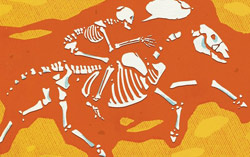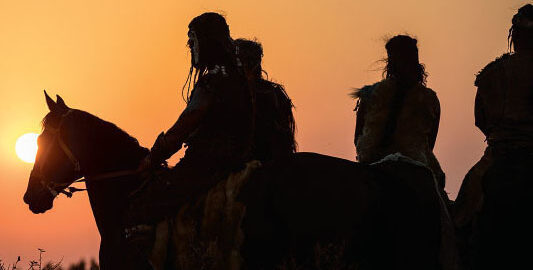
The Noble Ones
Hittite cavalry relief. Museum of Anatolian Civilizations (Georges Jansoone). Wikimedia Commons.
The Aryans or “Noble Ones” were thought to have remained together on the Caucasian steppes from about 4500 BCE until about 2500 BCE when groups began to migrate. Their single language, known by linguists as Proto-Indo-European, evolved into many of the Asiatic and European languages such as Sanskrit, Persian, German, Gaelic, Latin, Greek, Russian, and English. The Indo-European language family has the largest number of speakers of all language families as well as the widest dispersion around the world.

Recent ancient DNA studies indicate that the Proto-Indo-European language likely traveled first with the Yamnaya steppe pastoralists when they migrated from the vast grasslands of the Eurasian steppes into Europe around 4000–3000 BCE. They were one of the earliest peoples to train horses and to have wheeled carts that allowed them to manage large herds comprising sheep, goats and cattle. Bringing their Corded Ware Complex culture with them, they spoke a language linked to Proto-German, from which all of today’s 400 Indo-European languages spring. They interbred with local Europeans, descendants of local hunter-gatherers and farmers who had come from Anatolia. Within a few hundred years, the Yamnaya contributed to at least half of central Europe’s genetic ancestry.

The later Andronovo peoples, whose ancestry matched the early farmers of Europe and the Yamnaya, spread back from Europe eastward into Central and South Asia in the following 1,500 years. They called themselves Aryans—which in Classical Sanskrit means “honorable,” “respectable,” or “noble.”
We will look more closely at the Aryans as an example of pre-Axial life for two reasons. First, we know a lot about their life from an early written source: the Avesta. Second, their story shows clearly the type of conditions under which a transition from pre-Axial to Axial thought took place in all Axial communities. The Avesta was transmitted orally until the Axial Age when it became the foundational scripture of what, in many respects, may be called the very first Axial religion: Zoroastrianism.

The Aryans had no formal governing structures as far as we know, though each tribe had two groups: the priests, and everyone else, the producers. They led peaceful, fairly static, simple lives. Karen Armstrong in her book The Great Transformation tells us: “Like other ancient peoples, the Aryans experienced an invisible force within themselves and in everything that they saw, heard, and touched. Storms, winds, trees, and rivers were not impersonal, mindless phenomena. The Aryans felt an affinity with them, and revered them as divine. Humans, deities, animals, plants, and the forces of nature ‘spirit,’ which the Avestans called mainyu and the Sanskrit-speakers manya. It animated, sustained, and bound them all together.”
As time went on their beliefs became formalized into a pantheon of gods, with an overall God of the Sky called Dyaus Pitr, creator of the world, until he became too remote and was forgotten in favor of more accessible deities. These were easily identified with natural and cosmic forces: the god of the sun, the gods of the earth, the moon and the winds. Fire, water and the Soul of the Bull were gods associated with ritual practices and as such were particularly venerated.
In addition, they had a class of gods called Ahuras—associated with oaths and promise-keeping. The Ahuras originally included a divine power to enforce oaths that later became the responsibility of three main Ahuras: Varuna the guardian of order, Mithra the god of storm, thunder and rain, and Mazda the lord of justice and wisdom. These three Ahuras were assisted by Devas. Speech was a Deva—so oaths, once uttered, were absolutely binding and lies, once told, were absolutely evil. The sound of a chant was holy, and the act of listening was a sacred act, bringing the listener nearer to the gods. Other Devas were the gods of courage, friendship, glory, and justice. In the teachings of Zoroaster, as the beginning of the Axial Age approaches, Ahura Mazda would become a supreme being.
Daily religious ritual and sacrifice to the gods helped the Aryans maintain productivity, harmony and Rta Asha—a kind of natural law that maintained a cosmic order against Druj—disorder.
According to the Avesta, the earth was created in seven stages. First, the sky came into being—this was an inverted bowl of beautiful stone. Second, the water was created at the bottom of the sky shell, and then third, the earth that floated on water. Fourth, the gods added one plant, fifth, one animal (a bull), and then in the sixth stage, man. Fire was added in the seventh stage, pervading the entire world and residing in seen and unseen places.
As a final act of creation, the gods assembled and performed the first sacrifice. The primordial plant, the bull, and the man were crushed and from them the vegetable, animal and human realms were created and populated the earth. New life and death were created, and the world was set in motion. Self-sacrifice would become a central idea in the Axial Age. Without it, progress, whether materially or spiritually, would be impossible.
The Aryans performed rituals that reenacted this primordial sacrifice to maintain cosmic order and ensure the continuation of the life cycle. Ritual libations and sacrifices were performed at fire altars both in the home and in public spaces where sacred fires were kept burning. They would ensure that vital elements were returned to the gods who in turn would sustain their way of life on earth.

The Aryans revered life, and like all pre-Axial peoples, they felt a strong affinity between themselves and animals. They ate only consecrated animal flesh that had been offered to the gods, with prayers to ensure the animal’s safe return to the Soul of the Bull. They believed the Soul of the Bull was the life energy of the animal world, whose spirit was energized through their sacrifice of animal blood. This nourished the deity, helped the gods look after the animal world and ensured plenty. Animal sacrifice and other most sacred rituals required special sacred spaces and professional priests.
The primordial plant, the bull, and the man were crushed and from them the vegetable, animal and human realms were created and populated the earth.
An important ritual included a sacred beverage called Soma or Haoma made from a plant that is unknown today. This “golden drink” had properties that allowed the drinker to be ecstatically transported to the realm of the gods. Under its influence he achieved a sense of immortality and freedom from suffering and fear. He communed with the gods, expanding his mind to consider the deepest possibilities of life. This, of course, was a temporary experience, one that the heirs of these techniques would later, in the Axial Age, seek to achieve through introspection and ascetic practices.
The Andronovo were the first to ride horse-drawn spoked-wheeled chariots, which they did first from about 2000 BCE. Their sudden mobility and the obvious advantages it conferred completely disrupted the stable, conservative culture, which erupted into areas of widespread lawlessness.
[The Aryans’] sudden mobility completely disrupted the stable, conservative culture, which erupted into areas of widespread lawlessness.
With this chaotic new way of life, with men stealing and looting sheep and cows rather than tending them, a third class of individuals arose. These were the warlords (thieves) and professional warriors, whose lives were spent in raiding, rough living and hard drinking, and whose ambitions were to gain personal wealth and glory. Respect for Rta asha, the natural order central to life up to this point, was disrupted as villages and towns were wiped out, and might ruled the day. New gods became acceptable to this warrior class, the god Indra, for example, who drank the sacred soma to fuel his warlike frenzy, passion and daring, was worshipped far more than Varuna. Traditional Aryans were now bewildered, frightened, many of them suffering and completely disoriented by the chaos that now threatened their erstwhile conservative lives.
It was as a reaction to this suffering, chaos and perceived evil-doing that the prophet Zoroaster arose in what is now Iran.

Around 1500 BCE, the Aryans crossed the Hindu Kush mountains and came in contact with the Indus Valley Civilization. This was a large migration that scholars used to think caused the collapse of the Indus Valley Civilization, but, since there is no evidence of an invasion or mass movement, more recent speculation is that different Aryan bands gradually infiltrated the Indian continent.
That the Aryans came from outside India was the traditional understanding, but this interpretation was contested by a revisionist position claiming that Aryan culture and religion originated within India and developed from the Indus Valley Civilization.
Genetic data solved the issue once and for all. It also revealed that all but one of the steppe-enriched populations are historically priestly groups, including Brahmins—traditional custodians of texts written in the ancient Indo-European language Sanskrit.
“The finding that Brahmins often have more steppe ancestry than other groups in South Asia, controlling for other factors, provides a fascinating new argument in favor of a steppe origin for Indo-European languages in South Asia,” said David Reich, professor of genetics in the Blavatnik Institute at Harvard Medical School.
As Karen Armstrong says: “The language of the ritual Sanskrit text known as the Vedas (Knowledge) is so similar to Avestan and its cultural assumptions so close to the Gathas that it is almost certainly an Aryan scripture.”
External Stories and Videos

How Horses Changed the World: How Horse-Riding in Eurasia Advantaged Huns, Mongols over Farmers
Mariette Le Roux, Informed Comment
Taming horses opened a new world, allowing prehistoric people to travel farther and faster than ever before, revolutionizing military strategy, and spreading disease. The latest genetic research suggests the practice may have begun with Botai hunter-gatherers who lived in what is now modern Kazakhstan from about 3700 BCE to 3100 BCE.

New Evidence Fuels Debate over the Origin of Modern Languages
Roni Jacobson, Scientific American
Nomadic horse riders likely opened a “steppe bridge” between Europe and Asia, but recent genetic data raise more questions.

How Horses Changed the World: Finding the First Horse Tamers
Michael Price, Science
Genes suggest that Central Asian hunter-gatherers, not famed Yamnaya herders, first domesticated horses.
